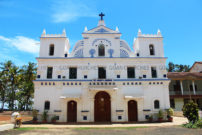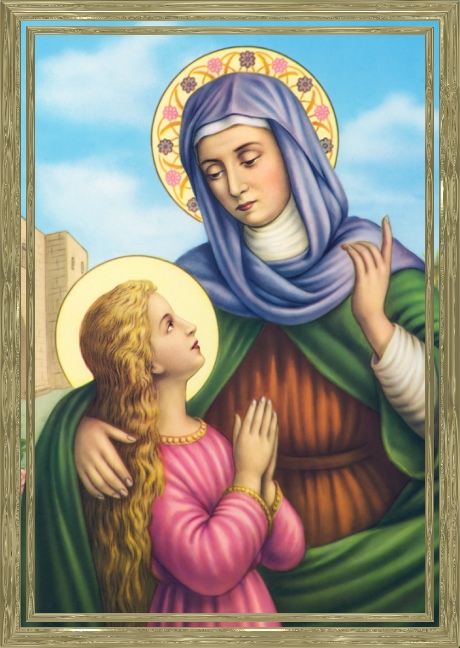
St. Anne

St. Anne (also known as Ann or Anna or Anne, from Hebrew Channah חַנָּה, meaning “favor” or “grace”) of David‘s house and line, was the mother of the Virgin Mary and grandmother of Jesus Christ, according to Christian and Islamic tradition. Mary’s mother is not named in the canonical gospels, nor in the Qur’an. St. Anne’s name and that of her husband Joachim come only from New Testament apocrypha, of which the Protoevangelium of James (written perhaps around 150) seems to be the earliest that mentions them.
The story bears a similarity to that of the birth of Samuel, whose mother Hannah had also been childless. Although Anne receives little attention in the Western church prior to the late 12th century, dedications to St. Anne in the Eastern church occur as early as the 6th century.[2] In the Eastern Orthodox Churches and Eastern Catholic Churches, she is revered as Hannah. In the Eastern Orthodox tradition, Hannah is ascribed the title Forbear of God, and both the Birth of Mary and the Dedication of Mary to the Temple are celebrated as two of the Twelve Great Feasts. The Dormition of Hannah is also a minor feast in the Eastern Church. In Protestant tradition it is held that Martin Luther chose to enter religious life as a Roman Catholic Augustinian monk after crying out to St. Anne.
Although the canonical books of the New Testament never mention the parents of the Virgin Mary, traditions about her family, childhood, education, and eventual betrothal to Joseph developed very early in the history of the church. The oldest and most influential source for these is the apocryphal Protevangelium of James, first written in Greek around the middle of the second century. In the West, the Protevangelium fell under a cloud in the fourth and fifth centuries when it was accused of “absurdities” by St. Jerome and condemned as untrustworthy by Popes Damasus I, Innocent I, and Gelasius I.
In the Eastern church, the cult of St. Anne herself may go back as far as c. 550, when Justinian built a church in Constantinople in her honor. The earliest sign of her veneration in the West is an 8th-century fresco in the church of Santa Maria Antiqua, Rome. A shrine at Douai, in northern France, was one of the early centers of devotion to St. Anne.
Two well-known shrines to St. Anne are that of Ste. Anne d’Auray in Brittany, France; and that of Ste. Anne de Beaupré near the city of Québec. The number of visitors to the Basilica of Ste. Anne de Beaupré is greatest on St Anne’s Feast Day, July 26, and the Sunday before Nativity of the Virgin Mary, September 8. In 1892, Pope Leo XIII sent a relic of St Anne to the church.
In the Maltese language, the Milky Way galaxy is called It-Triq ta’ Sant’Anna, literally “The Way of St. Anne”.
The supposed relics of St. Anne were brought from the Holy Land to Constantinople in 710 and were kept there in the church of St. Sophia as late as 1333. During the twelfth and thirteenth centuries, returning crusaders and pilgrims from the East brought relics of Anne to a number of churches, including most famously those at Apt, in Provence, Ghent, and Chartres. St. Anne’s relics have been traditionally preserved and venerated in the many cathedrals and monasteries dedicated to her name, for example in Austria, Canada, Germany, Italy, and Greece in Holy Mount and the city of Katerini. Medieval and baroque craftsmenship is evidenced in the striking metalwork of the life-size reliquaries containing the bones of her forearm for example. Examples employing folk art techniques are also known.
Düren has been the main place of pilgrimage for Anne since 1506, when Pope Julius II decreed that her relics should be kept there.
St. Anne is patroness of unmarried women, housewives, women in labor, grandmothers, horseback riders, cabinet-makers, and the Mi’kmaq people of Canada. As the Mother of the Blessed Virgin Mary, the devotion to St Anne as the patron of miners arises from the medieval comparison between the Virgin Mary and Christ and precious metals – silver and gold. Anne’s womb was considered the source from which these precious metals were mined. St Anne is also said to be a patron saint of sailors and a protector from storms.
She is also the patron saint of: Brittany; Castelbuono, Sicily; Quebec, Canada; Santa Ana, California; Norwich, Connecticut; Detroit, Michigan;[17] Santa Ana Pueblo; Adjuntas, Puerto Rico; Santa Ana, El Salvador; Jucuarán, El Salvador; Berlin, New Hampshire; Seama, New Mexico; Taos, New Mexico; Chiclana de la Frontera, Spain; Marsaskala; Tudela, Navarre; Hagonoy, Bulacan and Santa Ana, Taguig City, Philippines; St.Anne Shrine, Malicboy, Pagbilao, Quezon, Philippines ;Santana, São Paulo, Brazil; Saint Anne, Illinois; Sainte Anne Island, Seychelles; Baie Sainte Anne, Praslin Island, Seychelles; Bukit Mertajam and Klang Malaysia and South Vietnam, and Fasnia, and Kľúčové Slovakia. The parish church of Vatican City is Sant’Anna dei Palafrenieri.
The subject of Joachim and Anne The Meeting at the Golden Gate was a regular component of artistic cycles of the Life of the Virgin. The couple meet at the Golden Gate of Jerusalem and embrace. They are aware of Anne’s pregnancy, of which they have been separately informed by an archangel. This moment stood for the conception of Mary, and the feast was celebrated on the same day as the Immaculate Conception. Art works representing the Golden Gate and the events leading up to it were influenced by the narrative in the widely read Golden Legend of Jacobus de Voragine. The Birth of Mary, the Presentation of Mary and the Marriage of the Virgin were usual components of cycles of the Life of the Virgin in which Anne is normally shown.
Her emblem is a door.
Anne is never shown as present at the Nativity of Christ, but is frequently shown with the infant Christ in various subjects. She is sometimes believed to be depicted in scenes of the Presentation of Jesus at the Temple and the Circumcision of Christ, but in the former case, this likely reflects a misidentification through confusion with Anna the Prophetess. There was a tradition that Anne went (separately) to Egypt and rejoined the Holy Family after their Flight to Egypt. Anne is not seen with the adult Christ, so was regarded as having died during the youth of Jesus.[18] Anne is also shown as the matriarch of the Holy Kinship, the extended family of Jesus, a popular subject in late medieval Germany; some versions of these pictorial and sculptural depictions include Emerentia who was reputed in the 15th Century to be Anne’s mother. In modern devotions, Anne and her husband are invoked for protection for the unborn.
The role of the Messiah’s grandparents in salvation history was commonly depicted in early medieval devotional art in a vertical double-Madonna arrangement known as the Virgin and Child with Saint Anne. Another typical subject has Anne teaching the Virgin Mary the Scriptures (see gallery below).